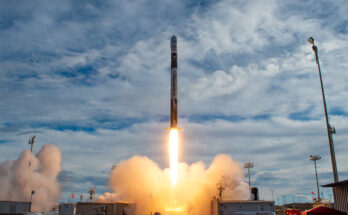Recent Decline Continued, but Stage Set for Renewed Activity in 2017
by Bill Ostrove, Space Systems Analyst, Forecast International.
The year 2016 saw 85 launches into Earth orbit (this count excludes the Falcon 9 that exploded in September, since the explosion occurred during the pre-launch phase). Launches were carried out by nine countries, utilizing 22 different launch vehicle families, built by 13 different manufacturers or organizations.
Here are some highlights:
- First launch of a Chinese Long March 5 (CZ-5)
- Successful return landings of multiple Falcon 9 first stages
- Return to flight of Orbital ATK’s Antares and Pegasus rockets
- Emergence of the Indian PSLV in the international commercial launch market
On the downside, Russian Protons logged a significantly lower launch rate.
Launches and Payloads

Launch numbers in 2016, like those in 2015, were down from a high point in 2014. The decline is due to a lower number of Russian launches, as that country deals with problems in its launch industry. Increased launch rates in the U.S. and China were not enough to make up for the Russian decline.
While the number of launches declined, the success rate has remained steady—holding at about 96 percent over the past five years. Three launch failures occurred in 2016:
- On August 31, a Chinse Long March 4C (CZ-4C) failed to carrying the Gaofen-10 remote sensing satellite into a sun synchronous orbit following an anomaly with the third stage.[i]
- On December 1, a Russian Soyuz U carrying the Progress MS-04 freighter filled with supplies for the International Space Station.[ii]
- On December 28, a Chinese Long March 2D (CZ-2D) failed to place its payload, consisting of two Gaojing remote sensing satellites and one 2U CubeSat, into the appropriate orbit. Details are still unclear regarding the launch.[iii]
As noted above, though not counted among these failures because it did not lift off, a SpaceX Falcon 9 exploded while being fueled on the launch pad on September 1.
In 2016, payloads launched also declined. In the four previous years, the number of payloads carried had risen from 136 in 2012 (1.77 payloads per launch) to 264 in 2015 (3.03 payloads per launch). Then, in 2016, the number of payloads declined to 214, while the number of payloads per launch declined to 2.52.
The rise in payloads per launch had been a result of the proliferation of small satellites. Their small size and light weight allow multiple satellites to be packed into a single launch vehicle. That has resulted in launches carrying dozens of payloads. For example, an Atlas V that lifted off in March 2016 carried an Orbital ATK Cygnus cargo transfer vehicle loaded with 30 small satellites for universities and commercial companies like Planet and Spire.
Prior to 2016, popular launch vehicles for multiple payloads included Russia’s Dnepr and Orbital ATK’s Antares. But the Dnepr did not launch at all in 2016 and the Antares launched only once, thus limiting availability of slots for smalls satellite operators.
The decline in payloads is not expected to last. As 2017 begins, the Antares is operational once again, and while the Dnepr will not likely launch again, others are moving into the market. ISRO, for example, plans to carry 83 satellites on a single GSLV this year, while Spaceflight Industries will carry 89 payloads on its Sherpa satellite deployer. In addition, the upcoming introduction of dedicated launch vehicles to carry small satellites, such as Virgin Galactic’s LauncherOne and Rocket Lab’s Electron, will provide additional slots for small satellite operators.
Launch Vehicles

Russia’s Soyuz has been the most popular launch vehicle for decades. Russia has launched well over 1,000 variants of the Soyuz launch vehicle since its introduction in the 1960s, with 14 blasting off in 2016.
Though a relative new-comer to the international launch market, the Falcon 9 has quickily taken a top position in launch rates – thanks to its low price and its contracts with NASA. In addition to its noteworthy increase in launch rates, SpaceX has accomplished another feat: successfully returning a Falcon 9 first stage five times in eight launches. Still, SpaceX has a way to go before the Falcon 9 reaches its full potential. The company will have to increase the launch rate to fulfill all commitments on its large launch roster. In addition, the rocket has exploded twice in two years. While the Falcon 9 still has a 93 percent success rate, SpaceX would do well to improve that figure going forward.
The Proton is notable due to its relatively low place in the rankings. The Proton was once one of the dominant launch vehicles, carrying both commercial and military payloads. However, problems within the Russian launch industry have reduced reliability of the rocket, and commercial customers have responded by switching to competitors like the Ariane 5 and Falcon 9.
Still, it’s too soon to count the Proton out. International Launch Services (ILS), which markets the Proton commercially, announced in 2016 that it is working with prime contractor Khrunichev to develop new, smaller variants of the Proton, which will lower costs and improve competitiveness with other smaller launch vehicles like the Falcon 9.[iv] Also, Russia continues to focus on improving reliability, consolidating much of the industry, which it expects will lower overhead costs and improve oversight.[v]
Other notable launch vehicles include the PSLV, Antares, Pegasus, and Long March 5. The PSLV’s low price, high success rate, and strong domestic demand have caused a significant increase in launch rates, reaching six in 2016. The Antares and Pegasus represent big successes for Orbital ATK. The Antares returned to flight after an October 2014 launch failure and an upgrade to its first stage rocket motor. The Pegasus returned to flight for the first time since 2013. Orbital ATK has had difficulty getting contracts for the Pegasus due to its relatively high price, but the Pegasus continues to generate contracts and Orbital ATK plans to continue production.[vi] The first launch of a Long March 5 represents a major achievement for China’s space program. It is the largest rocket ever built and launched by China and will enable the country to achieve its ambitious goals in space, including deploying a multi-module space station by 2020.
The Big Players: By Country
 The United States and China conducted the most launches in 2016, with 22 each, together capturing about 51.8 percent of the market. As mentioned earlier, Russia’s launch industry has suffered from reliability issues, resulting in a major decline in the number of Russian launches in 2016. Russia conducted only 19 launches in 2016, compared to 38 in 2015.
The United States and China conducted the most launches in 2016, with 22 each, together capturing about 51.8 percent of the market. As mentioned earlier, Russia’s launch industry has suffered from reliability issues, resulting in a major decline in the number of Russian launches in 2016. Russia conducted only 19 launches in 2016, compared to 38 in 2015.
Other major players in the launch market include France, India, Japan, and Italy.
The Major Players: Manufacturers

The China Aerospace Science and Technology (CAST) Corp, which is the parent to the China Academy of Launch Vehicle Technology (CALT), and the Shanghai Academy of Space and Technology (SAST) produced the most launch vehicles in 2016. Under China’s state-controlled enterprise system, a single company produces most launch vehicles. In the U.S., a more competitive industry has arisen, with ULA, SpaceX, and Orbital ATK acting as prime contractors for launch vehicles that serve both government and commercial customers.
Other major manufacturers include TsSKB Progress, which produces the Soyuz; Airbus, which produces the Ariane 5; ISRO, which produces the PSLV; Khrunichev, which produces the Proton; and MHI, which produces the H-II.
A Look Ahead
Now it’s appropriate to look ahead to 2017. The declining trend in number of payloads carried between 2015 and 2016 will not continue in 2017. In fact, two launches this year will carry more than 80 satellites each. The demand for small satellites continues to be strong, driving demand for secondary payloads.
This year will also see continued development of reusable launch vehicles. SpaceX plans to reuse one of the Falcon 9 first stages that landed in 2016 to carry a payload to orbit. Blue Origin will also continue development of its New Shepard crew vehicle and New Glenn rocket.
Lastly, in 2017, the U.S. and China will continue to dominate the launch industry. China’s launch industry is driven by its ambitious goals, laid out in a 2016 white paper, to expand its presence in commercial, military, and science arenas. In the U.S., entrepreneurial innovation will continue to drive space launches. Companies like SpaceX, Virgin Galactic, and Blue Origin are lowering the cost to launch. As the cost comes down, more organizations will be able to afford to send missions into Earth orbit.
Please feel free to use this content with Forecast International and analyst attributions, along with a link to the article. Contact Ray Peterson at +1 (203) 426-0800 or via email at ray.peterson@forecast1.com for additional analysis.
Forecast International offers two Space Systems Forecast products: Launch Vehicles & Manned Platforms, with reports on manned spacecraft, expendable launch vehicles and more, and Satellites & Spacecraft, with coverage ranging from microsatellites to large COMSATs – all complete with technical specifications and forecast details.
[i] http://www.spacesafetymagazine.com/news/long-march-4c-gaofen-10-failure/
[ii] http://www.nasaspaceflight.com/2016/12/roscosmos-progress-ms-0465p-to-station/
[iii] http://spaceflight101.com/long-march-2d-gaojing-partial-launch-failure/
[iv] http://www.ilslaunch.com/newsroom/news-releases/ils-introduces-expanded-proton-line-cost-effective-launch-vehicles
[v] http://spacenews.com/russian-government-provides-debt-ridden-khrunichev-with-cash-and-loans/
[vi] http://spaceflightnow.com/2016/12/27/orbital-atk-has-no-plans-phase-out-seldom-used-pegasus-rocket/
A military history enthusiast, Richard began at Forecast International as editor of the World Weapons Weekly newsletter. As the Internet grew in importance as a research tool, he helped design the company's Forecast Intelligence Center and currently coordinates the EMarket Alert newsletters for clients. Richard also manages social media efforts, including two new blogs: Defense & Security Monitor, covering defense systems and international issues, and Flight Plan, which focuses on commercial aviation and space systems. For over 30 years, Richard has authored the Defense & Aerospace Companies, Volume I (North America) and Volume II (International) services. The two books provide detailed data on major aerospace and defense contractors. He also edits the International Contractors service, a database that tracks all the contractors involved in the programs covered in the FI library. More recently he was appointed Manager, Information Services Group (ISG), a new unit that encompasses developing outbound content for both Forecast International and Military Periscope.




